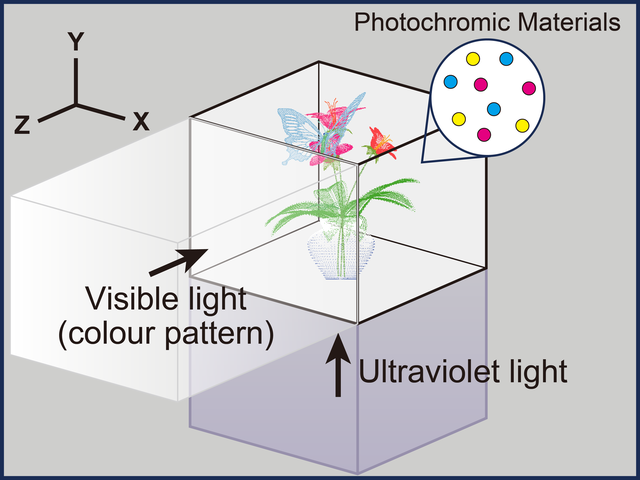Volumetric display
Volumetric displays render three-dimensional (3D) images directly onto a physical volumetric space, enabling observers to view natural 3D images from any direction without the need to wear special devices. Therefore, volumetric displays have received significant research attention as a 3D visualization technique for medical applications, architectural design, advertising, and entertainment. We aim to develop a novel human–computer interaction utilizing a unique 3D architecture of the volumetric displays.
3D structure containing multiple 2D patterns
A 3D structure designed by our proposed algorithm contains multiple 2D patterns and exhibits the patterns in different directions. Since our 3D structure can independently and simultaneously provide multiple 2D patterns with directional characteristics, the proposed algorithm can be applied to information service systems including digital signage and security system.
Dynamic full-color system providing multiple 2D patterns
As an application of our proposed algorithm, we are developing dynamic full-color volumetric displays exhibiting multiple 2D patterns. We actually have made two types of volumetric displays; i.e., arrays of light-emitting diodes (LEDs) arranged in a 3D layout and arrays of strings on which an image is projected, where the strings serve to scatter light. We are mainly working on a development of a large-scaled system.
Optically controlled volumetric display based on nanomaterials
We are developing an optically controlled volumetric display consisting of nanomaterials (e.g., quantum-dots and photochromic materials), which are controlled by irradiation with external light. Such optically controlled volumetric displays offer higher definition and higher resolution than conventional electrically controlled ones, which require electrical wirings that deteriorate spatial resolution and induce occlusion.

References
- Hirotaka Nakayama, Atsushi Shiraki, Ryuji Hirayama, Nobuyuki Masuda, Tomoyoshi Shimobaba and Tomoyoshi Ito, gThree-Dimensional Volume Containing Multiple Two-Dimensional Information Patterns,h Scientific Reports, 3, 1931 (2013). [link]
- Ryuji Hirayama, Makoto Naruse, Hirotaka Nakayama, Naoya Tate, Atsushi Shiraki, Takashi Kakue, Tomoyoshi Shimobaba, Motoichi Ohtsu and Tomoyoshi Ito, gDesign, Implementation and Characterization of a Quantum-Dot-Based Volumetric Display,h Scientific Reports, 5, 8472 (2015). [link]
- Ryuji Hirayama, Hirotaka Nakayama, Atsushi Shiraki, Takashi Kakue, Tomoyoshi Shimobaba and Tomoyoshi Ito, gImage quality improvement for a 3D structure exhibiting multiple 2D patterns and its implementation,h Optics Express, 24(7), 7319-7327 (2016). [link]
- Ryuji Hirayama, Atsushi Shiraki, Makoto Naruse, Shinichiro Nakamura, Hirotaka Nakayama, Takashi Kakue, Tomoyoshi Shimobaba and Tomoyoshi Ito, gOptical Addressing of Multi-Colour Photochromic Material Mixture for Volumetric Display,h Scientific Reports, 6, 31543 (2016). [link]